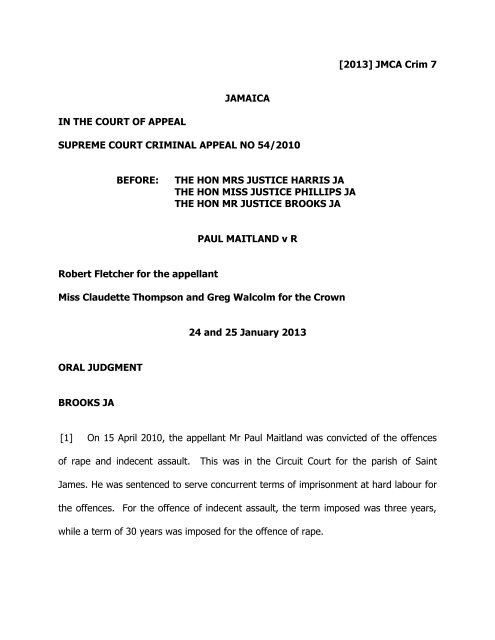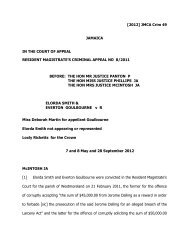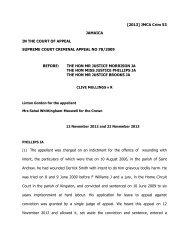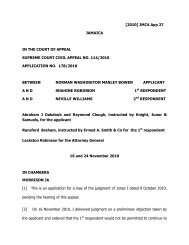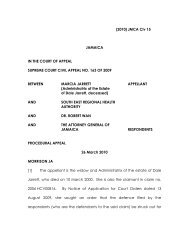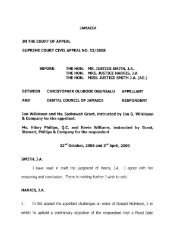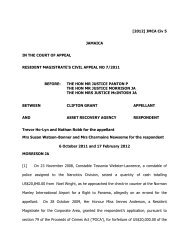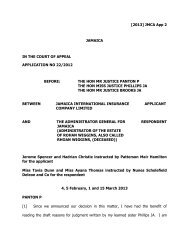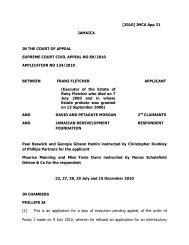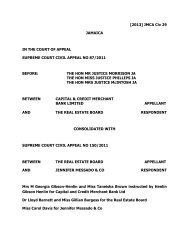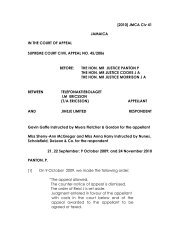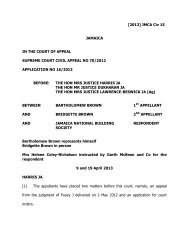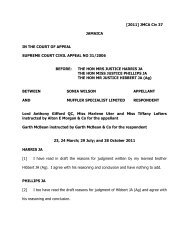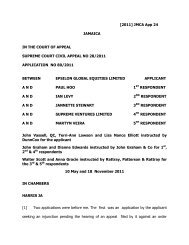Maitland (Paul) v R.pdf - The Court of Appeal
Maitland (Paul) v R.pdf - The Court of Appeal
Maitland (Paul) v R.pdf - The Court of Appeal
Create successful ePaper yourself
Turn your PDF publications into a flip-book with our unique Google optimized e-Paper software.
[2] Aggrieved by his conviction and sentence, Mr <strong>Maitland</strong> filed an application forpermission to appeal against them and to have them overturned. <strong>The</strong> two originalgrounds <strong>of</strong> appeal that he filed alleged that there was an “[u]nfair trial” and that therewas “[i]nsufficient evidence to warrant a conviction”.A single judge <strong>of</strong> this courtconsidered his application and was <strong>of</strong> the opinion that there were matters thatwarranted the consideration <strong>of</strong> the court. Permission to appeal was therefore granted.[3] Mr Fletcher, acting on Mr <strong>Maitland</strong>’s behalf, filed two supplemental grounds,namely, that:“1. <strong>The</strong> summation <strong>of</strong> the learned trial judge wasdeficient in certain critical areas and thesedeficiencies denied the appellant a fair trial.2. <strong>The</strong> sentence is manifestly excessive.”[4] Before considering these grounds, it would be <strong>of</strong> assistance to set out therespective cases <strong>of</strong> the prosecution and the defence.<strong>The</strong> prosecution’s case[5] <strong>The</strong> evidence for the prosecution was that on 4 October 2008 at about 9:15 pm,the complainant, referred to hereafter as C, was walking along a major thoroughfare inthe city <strong>of</strong> Montego Bay when she was accosted by two men. She had, only 15 secondsbefore, seen them walking toward her from the direction <strong>of</strong> a place called “City Centre”.She was heading toward City Centre and had seen their faces as they approached.Having passed her, the men turned back and held her, one at either side <strong>of</strong> her, and
put ratchet knives at her sides. One threatened to stab her with his knife if she did notobey his commands.[6] <strong>The</strong> men ordered her to walk with them and not to look at them. She compliedout <strong>of</strong> fear. <strong>The</strong>y forced her to walk some distance with them. <strong>The</strong> journey took themthrough the grounds <strong>of</strong> a church and those <strong>of</strong> Mount Alvernia High School, unto a paththat led to another road that led past Cornwall College, and along that road to an openlot on the side opposite to Cornwall College. It was a 15 minute trek.[7] At a spot in the open lot, one <strong>of</strong> them “tie a ‘kerchief around his face coveringhis nose”. He touched her on her breasts and on her vagina. He then left the otherman at that spot and took her a further distance into the open lot, where he forced her,at knife-point, to perform oral sex on him. He, thereafter, ordered her to remove herpanties and, upon her doing so, had sexual intercourse with her, from behind her andwithout her consent.[8] When he was through, he took her back to the spot where the other man waswaiting. That man then took her to the place from whence she had just come, and healso sexually assaulted her.[9] After threatening her not to move for a certain period, they left her in the openlot. She telephoned her boyfriend, told him <strong>of</strong> her ordeal and then made her way toCity Centre. Her boyfriend joined her there and together they waited for the arrival <strong>of</strong>the police, who had, by then, been contacted. While waiting, she saw the two men
again. This was about 10 minutes after they had left her in the open lot. <strong>The</strong>y lookedin her direction and laughed.[10] <strong>The</strong> police vehicle came and took her to the police station. While she waswaiting to be interviewed, the police brought in a man. It was the appellant. Cidentified him as the man who had first had sex with her that evening. She said that hewas also wearing the same clothing that he had on at the time <strong>of</strong> the assault on her.[11] <strong>The</strong> police <strong>of</strong>ficer who had apprehended the appellant said that, in response tothe complaint that he had received, he went, at about 10:00 o’clock that night, to anarea not far from City Centre. He saw two men and accosted them. <strong>The</strong>y ran. Hechased and held the appellant and took a ratchet knife from his person. He then tookhim to the police station where C identified him.[12] Forensic evidence provided the pr<strong>of</strong>ile <strong>of</strong> a female’s DNA on the appellant’sunderpants. <strong>The</strong> pr<strong>of</strong>ile matched C’s DNA, as ascertained from her blood samples andbuccal swabs.<strong>The</strong> probability that it was C’s DNA on the underpants, was3.3/100,000,000,000,000,000. <strong>The</strong> expert who gave that evidence also told the jurythat the world’s population is almost 7,000,000,000 and Jamaica’s population isapproximately 2,800,000. <strong>The</strong> conclusion was that “the chance <strong>of</strong> finding somebodywith that pr<strong>of</strong>ile is that rare”.
<strong>The</strong> case for the defence[13] Mr <strong>Maitland</strong> gave an unsworn statement from the dock. He said that he wascoming from a church on the night in question when he saw the police car approach.He said that a man who was walking behind him ran away. He, however, kept onwalking and the police approached him. He said that his clothes were wet from a ritualwhich had taken place at the church. <strong>The</strong> police took him to the police station and hewas made to sit with some other men.[14] While there, he said, the police brought C and her boyfriend and had C look at allthe men. She looked and shook her head. <strong>The</strong>reafter a police <strong>of</strong>ficer called “Mr Spy”brought C and her boyfriend to look where Mr <strong>Maitland</strong> was with the other men. MrSpy was, thereafter, engaged in whispering to C and her boyfriend.[15] He said that the account that C gave at the police station was that she and herboyfriend were walking together when “one man run out pon dem ‘roun a Cornwall”.<strong>The</strong> police did, however, take Mr <strong>Maitland</strong>’s underpants that night and were showingthem to C and her boyfriend.[16] Although he maintained that he had nothing to do with any rape or robbery,whatsoever, he sought to cast doubt on C’s account <strong>of</strong> the incident. He said that CityCentre was a place that had a security post and that any such abduction, as C haddescribed, could not have escaped notice. He said:“...nobody could go from KFC an bring them up pass KFC an[sic] bring dem down roun a cornwall [sic] as dem saying.Dere is security post, nobody a walk wid nobody all di way
ound deh soh goh all di way round deh soh. Mi nuh knownoting [sic] whey dem a talk bout, an security deh aCornwall.”Ground One: Deficiencies in the summation in respect <strong>of</strong> identificationevidence[17] Mr Fletcher set out in his written submissions, the argument that although thelearned trial judge gave the standard warning about relying on visual identificationevidence, she failed to “specifically bring to the jury’s attention weaknesses in [that]evidence, as is required”. According to Mr Fletcher, those weaknesses were:“1. <strong>The</strong> variable lighting which attended the journey inthe incident2. <strong>The</strong> fact that the time for the [identification] wasrelatively brief3. <strong>The</strong> difficult circumstances surrounding the incident –fright etc4. <strong>The</strong> fact that the circumstance [sic] <strong>of</strong> theidentification at the Police Station was highlysuggestible in that the appearance <strong>of</strong> the Appellantand a police <strong>of</strong>ficer at that time could prompt aninaccurate [identification].”[18] Learned counsel also included in those submissions, the argument that thelearned trial judge erred in failing to bring to the jury’s attention the implied assertionthat there may have been prompting by the police <strong>of</strong>ficers to secure C’s identification <strong>of</strong>the appellant.[19] In addressing this ground, it is to be noted that the learned trial judge did warnthe jury <strong>of</strong> the dangers <strong>of</strong> visual identification evidence.She did not, however,
specifically advise the jurors about the weaknesses <strong>of</strong> the identification evidence. <strong>The</strong>learned trial judge did mention the issues <strong>of</strong> fright, the time for which C saw the facesand the fact that it was night. She did not, however, deal with them in the context <strong>of</strong>the warning <strong>of</strong> the dangers <strong>of</strong> visual identification. In that regard, the learned trialjudge did run afoul <strong>of</strong> the requirements <strong>of</strong> a proper Turnbull direction (Turnbull v R[1976] 3 WLR 445). Whether that error is fatal to the conviction depends on theevidence in the case.[20] A defect in the summation may not necessarily be fatal to the conviction. InPeter Campbell v R SCCA No 17/2006 (delivered 16 May 2006), this court dismissedan appeal against conviction although the trial judge did not use the words, “a mistakenwitness can be a convincing one”. <strong>The</strong> trial judge’s communication <strong>of</strong> the relevantprinciples was what was important and the court found that he had fulfilled thatobligation.[21] In David Lyons v R SCCA No 82/2007 (delivered 30 July 2009), this courtconsidered a complaint that the learned judge at first instance in that case, failed todirect the jury in respect <strong>of</strong> the weaknesses in the identification evidence. McIntosh JA((Ag) as she then was), in giving the decision <strong>of</strong> this court, noted that the judge hadreviewed the identification evidence and had given the requisite warning. She acceptedthat the judge “did not expressly state that the areas highlighted were weaknesses”.<strong>The</strong> court found, however, that the approach taken by the judge was sufficient to bring
to the minds <strong>of</strong> the jury that those areas required careful consideration. Based on thatfinding the complaint on appeal was found to be without merit.[22] That approach may properly be adopted in the instant case. <strong>The</strong> learned trialjudge did tell the jury <strong>of</strong> the need to consider the various matters including the lighting.She did remind the jurors <strong>of</strong> the time <strong>of</strong> night, although, it is true, she placed morestress on the significant amount <strong>of</strong> artificial lighting that was present rather than on thefact that it was night. That would be a matter which would be open to the jury toassess based on their actual experience <strong>of</strong> visiting the scene. <strong>The</strong> learned judge alsodid not remind the jury that C did not look at the faces <strong>of</strong> either <strong>of</strong> the men as theyescorted her along the route to the open lot.[23] If there is other evidence which bolsters the identification evidence then an errorin the summation may not necessarily be fatal. <strong>The</strong> fact that other evidence maybolster that relating to identification, was in fact, recognised in Turnbull. Lord WidgeryCJ said at page 448G, that where the identification evidence is poor, the “judge shouldthen withdraw the case from the jury and direct an acquittal unless there is otherevidence which goes to support the correctness <strong>of</strong> the identification”(emphasis supplied).[24] In the instant case, three specific circumstances would have assisted the jury inconsidering the issue <strong>of</strong> visual identification. <strong>The</strong> first is the fact that the jury visitedthe location <strong>of</strong> the <strong>of</strong>fences starting from the point <strong>of</strong> abduction and walked the routethat the perpetrators used to the place where C was eventually assaulted. It is <strong>of</strong>
importance that the jury did so at night.<strong>The</strong>y were, therefore, able to see forthemselves, the lighting conditions <strong>of</strong> which C spoke and the variations in lighting onwhich Mr Fletcher commented.<strong>The</strong> actual experience would have made a vividimpression on the members <strong>of</strong> the jury.[25] <strong>The</strong> second element that would have bolstered the visual identification evidence,is the forensic evidence, namely, the match <strong>of</strong> the DNA on Mr <strong>Maitland</strong>’s underpantswith C’s DNA and the extremely low probability that the female DNA on the underpantswas from some other woman. <strong>The</strong> statistics would have had a telling effect on the jury.It is true that the learned trial judge seemed to have fallen into what is called “theprosecutor’s fallacy” when she addressed the issue <strong>of</strong> the DNA evidence. This is whenshe sought to state that only C could have left that stain on the underpants. <strong>The</strong>learned trial judge said at pages 48-49:“Now members <strong>of</strong> the jury, if you accept the scientificevidence called by the Crown, this indicates that there isonly one female in Jamaica and even in the world fromwhich this DNA <strong>of</strong> female could have come and thecomplainant is that female.”She did s<strong>of</strong>ten that position somewhat in the sentences that immediately followed thaterroneous statement:“If that is the position, the decision you have to reach on allthe evidence is whether you are sure that it was thecomplainant who left that stain there. So, you have to lookat that evidence carefully.”[26] Despite those errors, it may fairly be said that the evidence against Mr <strong>Maitland</strong>was very strong and that the jury would have convicted even if the errors had not been
made.If necessary, the proviso to section 14(1) <strong>of</strong> the Judicature (AppellateJurisdiction) Act should be applied.[27] <strong>The</strong> third element that strengthened the identification evidence is C’s evidencethat when she saw Mr <strong>Maitland</strong> at the police station he was wearing the same clothingthat the perpetrator had on at the time that the <strong>of</strong>fences were committed. Given therelatively short period (half an hour), between the time <strong>of</strong> the commission <strong>of</strong> the<strong>of</strong>fences and the time <strong>of</strong> the identification at the police station, the jury would havebeen entitled to consider this as supporting the correctness <strong>of</strong> C’s identification <strong>of</strong> Mr<strong>Maitland</strong>.It is accepted that the period <strong>of</strong> time was not as short as in KerrickThompson v R SCCA No 206/2001 (delivered 20 December 2004). In that case theapprehension <strong>of</strong> an injured Mr Thompson was very soon after an exchange <strong>of</strong> gunfirebetween the police and criminal gunmen, one <strong>of</strong> whom dropped a gun during theexchange. Mr Thompson was also wearing clothing identical to the man who droppedthe firearm. <strong>The</strong> case does, however, lend support to the principle that evidence as toclothing can support visual identification evidence.[28] Ground one, accordingly, fails.Ground Two: <strong>The</strong> sentence is manifestly excessive.[29] Mr Fletcher argued, in support <strong>of</strong> this ground, that a review <strong>of</strong> relatively recentdecisions in cases involving sentences as punishment for rape shows that the sentence<strong>of</strong> 30 years in this case was manifestly excessive. He cited the cases <strong>of</strong> R v KentonSalmon SCCA No 176/2006 (an oral judgment delivered 14 November 2012), Sheldon
Brown v R [2010] JMCA Crim 38, <strong>Paul</strong> Allen v R [2010] JMCA Crim 79 and MarvinReid v R [2011] JMCA Crim 50.[30] Kenton Salmon was convicted <strong>of</strong> illegal possession <strong>of</strong> firearm, rape, burglary androbbery with aggravation. <strong>The</strong> evidence against him was that he and another manbroke into a house in which the complainant, a schoolgirl over the age <strong>of</strong> 16, wassleeping. Mr Salmon was the principal <strong>of</strong>fender, being the man armed with the firearmand taking the lead role. Both men raped the complainant twice, in turns. <strong>The</strong>y alsorobbed her <strong>of</strong> money and her cellular telephone. He was sentenced, on conviction, to25 years imprisonment for the <strong>of</strong>fence <strong>of</strong> rape.[31] This court, reduced that sentence to one <strong>of</strong> 18 years on the basis that thelearned trial judge, in imposing sentence, did not consider the elements <strong>of</strong> rehabilitationand the particular circumstances <strong>of</strong> the <strong>of</strong>fender. <strong>The</strong> court found that the sentencewas somewhat out <strong>of</strong> the range <strong>of</strong> the sentences usually imposed for the <strong>of</strong>fence. Itdoes not appear, however, that the cases mentioned below were brought to theattention <strong>of</strong> the court at that time.[32] In Sheldon Brown, the complainant was abducted from her home, taken tovarious places and raped several times by the applicant. He returned her to her homeand raped her yet again. She suffered this ordeal in the context <strong>of</strong> the applicant havinginformed her that he had been contracted to kill her. This court had no difficulty inaffirming the sentence <strong>of</strong> 20 years imprisonment at hard labour that was imposed uponconviction.
[33] In Marvin Reid, the complainant was abducted at gunpoint as she walked alonga roadway. She was taken to a house where two men raped her. <strong>The</strong> sentence <strong>of</strong> 10years imprisonment was not disturbed.[34] <strong>Paul</strong> Allen’s case involved a sentence <strong>of</strong> 20 years for the <strong>of</strong>fence <strong>of</strong> rape. <strong>The</strong>evidence was that the complainant in that case was abducted at gunpoint from a streetin Montego Bay. Her attacker took her to a house where he raped her, indecentlyassaulted her and robbed her <strong>of</strong> cash.On appeal, there was no reduction <strong>of</strong> thesentences imposed for the individual <strong>of</strong>fences, although a consecutive element wasoverturned.[35] It may be fair to say that the sentence imposed in Marvin Reid was significantlyless than the norm. It may, therefore, be excluded from this analysis. <strong>The</strong> cases <strong>of</strong>Sheldon Brown and <strong>Paul</strong> Allen did not involve two rapists, as in the instant case, butthey do indicate a level <strong>of</strong> sentence that this court considers appropriate. <strong>The</strong> fact thattwo perpetrators defiled C cannot be ignored. Although only one person has beenconvicted <strong>of</strong> the <strong>of</strong>fence, and it may be said that he should only be punished for hisacts, the fact remains that he was present and supporting the other <strong>of</strong>fender. <strong>The</strong> fact<strong>of</strong> the multiple rapes warrants a sentence greater than that imposed on a man who actsalone, providing that there is no unusual depravity or other aggravating circumstance.[36] Although the overall effect on C cannot be ignored, it seems that thecircumstances <strong>of</strong> this case are not so different from those in <strong>Paul</strong> Allen to warrant an
additional 10 years imprisonment. <strong>The</strong> circumstances <strong>of</strong> the instant case are not farremoved from those in Kenton Salmon. As in Kenton Salmon, the learned trialjudge in the instant case did not specifically address the issue <strong>of</strong> rehabilitation but shewas addressed on that issue in mitigation and she did consider Mr <strong>Maitland</strong>’s uniquesituation. She said, at page 58 <strong>of</strong> the record:“You have admitted to two previous convictions, and as yourattorney said, between 2004 and 2008 you have managed tokeep yourself out <strong>of</strong> trouble, according to the records.”[37] Despite the similarities with Kenton Salmon, it seems that 18 years isinadequate punishment when all is considered. This court has a duty to be “aware <strong>of</strong>the state <strong>of</strong> crime in the country and the current outcry <strong>of</strong> the populace against thespate <strong>of</strong> crimes involving the defilement <strong>of</strong> women and young children” (see Regina vKory White (1997) 34 JLR 30 at page 45). Since that case, this country has seenseveral horrible cases <strong>of</strong> that ilk and our courts must reflect the outrage that the societyhas expressed against their occurrence, always bearing in mind, <strong>of</strong> course, all theprinciples to be observed in imposing sentences.[38] In the instant case, what must be considered would include the ordeal to whichC was subjected, the fact that Mr <strong>Maitland</strong> was 35 years old at the time <strong>of</strong> conviction,did not employ a firearm in the commission <strong>of</strong> the <strong>of</strong>fences and had a previousconviction for an <strong>of</strong>fence involving the person <strong>of</strong> another, namely, robbery withaggravation. An appropriate sentence would be 23 years imprisonment.In the
circumstances, the sentence <strong>of</strong> 30 years would be manifestly excessive. This courtmay, therefore, set it aside and substitute a lower term.Separate consideration <strong>of</strong> <strong>of</strong>fences[39] <strong>The</strong> court was concerned that the learned trial judge had failed to specificallydirect the jury <strong>of</strong> their duty to give separate consideration to the evidence concerningeach <strong>of</strong>fence charged on the indictment. She did, however, give accurate guidanceconcerning what had to be proved in respect <strong>of</strong> each <strong>of</strong>fence. In giving her final chargeto the jury the learned trial judge also indicated the options open to them on eachcount. She said at page 51 <strong>of</strong> the record:“<strong>The</strong> verdict on count one is, not guilty or guilty <strong>of</strong> rape andon count two, not guilty or guilty <strong>of</strong> indecent assault.”It is undoubtedly true that she did not direct the jury that a verdict in respect <strong>of</strong> one <strong>of</strong>the counts did not bind them to a similar verdict in respect <strong>of</strong> the other count. In theinstant case, however, where the issues joined were those <strong>of</strong> identification and C’scredibility, and not whether the acts <strong>of</strong> violation occurred, but the learned trial judge’serror cannot be held to be fatal to the conviction.Conclusion[40] Although the learned trial judge failed to specifically bring the weaknesses in theidentification evidence to the attention <strong>of</strong> the jury in the context <strong>of</strong> warning them <strong>of</strong> thedangers <strong>of</strong> visual identification, the strength <strong>of</strong> the evidence against Mr <strong>Maitland</strong> is suchthat the jury would have convicted him even if they had been correctly directed. <strong>The</strong>rehas therefore been no miscarriage <strong>of</strong> justice.
[41] <strong>The</strong> sentence <strong>of</strong> 30 years imposed for the <strong>of</strong>fence <strong>of</strong> rape is, however,significantly outside the range <strong>of</strong> recent decisions and can be said to be manifestlyexcessive.[42] As a result, the appeal against conviction is dismissed. <strong>The</strong> appeal againstsentence is allowed in part. <strong>The</strong> sentence <strong>of</strong> 30 years for the <strong>of</strong>fence <strong>of</strong> rape is setaside and a sentence <strong>of</strong> 23 years at hard labour substituted therefor. It is to be servedconcurrently with the sentence <strong>of</strong> three years for the <strong>of</strong>fence <strong>of</strong> indecent assault, whichis confirmed. <strong>The</strong> sentences are to be reckoned as having commenced on 22 July2010.


